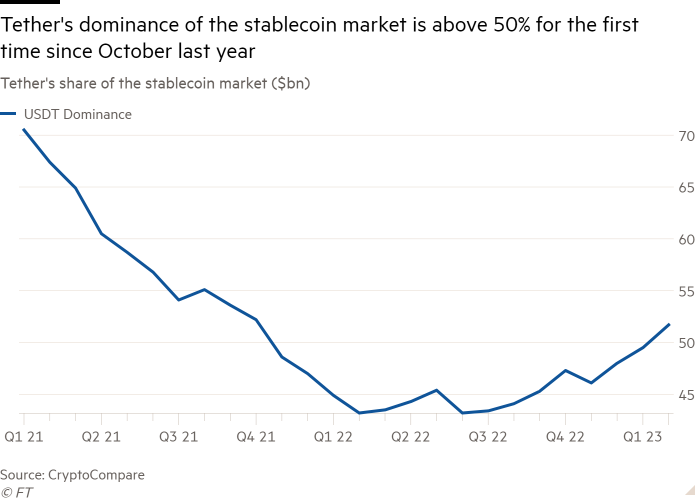The Two Sides of Crypto in the Ukraine War
Hello and welcome to the latest edition of the FT’s Cryptofinance newsletter. One year after Russia’s invasion of Ukraine, we look at the role crypto has played in the conflict
Crypto’s impact on geopolitical issues doesn’t often make for uplifting reading. The US, for example, fears that digital assets could offer actors under sanctions a new means of looping the financial system.
But the war in Ukraine has shown that the use of crypto in international affairs is far more nuanced and complicated. Blockchain data analytics company Elliptic shared data with the FT showing that private crypto fundraising for pro-Ukrainian purposes has outpaced Russian equivalents at a rate of 44 to one over the past year.
In total, more than $200 million worth of crypto has gone to what have been described as pro-Ukrainian purposes. Over $80 million of these funds were sent directly to the Ukrainian government.
Just weeks after the invasion, a Ukrainian politician said that crypto had helped supply its armed forces with supplies including bulletproof vests, helmets and walkie talkies. Other funds went to humanitarian purposes, and even journalism and intelligence efforts.
Not only do these funds eclipse the less than $5 million sent to pro-Russian entities, they represent at least a fifth of total non-state aid to Ukraine, marking the first time in history that crypto has played a significant role in a great conflict.
“Ukraine made a big bet on crypto by offering donation addresses literally hours after the invasion, and it paid off,” said one Elliptical analyst who spoke to me on condition of anonymity. “Twenty percent of grassroots funding coming from crypto is no small feat,” they added.
If you’ve subscribed to this newsletter for a while, you’ll remember that a few weeks ago I questioned crypto’s utility as a force for good, as hard-to-use crypto tokens poured into Turkey and Syria in the days following the region’s tragic earthquake. But in Ukraine, crypto has proven to have some social utility.
So can crypto claim to be a force for legitimate good? Possibly, but as crypto fans also say, the technology is neutral and can be used in a variety of ways.
Of the nearly $5 million worth of crypto donated to pro-Russian entities, more than half of those funds were dedicated to military fundraising, with most originating from exchanges and brokerage services — a particular strand of crypto technology that has drawn the ire of Western governments. last months.
These groups often provide expense reports on the messaging platform Telegram. Elliptic estimates that MOO “Veche” – a military fundraising group active in Donbas – has received approximately $1.8 million in bitcoin, which would make it the richest pro-Russian fundraising group of crypto holdings.

A collection of supplies donated by MOO “Veche” © Elliptic
Elliptic’s research also highlights a “particularly brutal” use of cryptocurrency that traces to Rusich, a paramilitary fighting group known for neo-Nazi symbolism. The organization – also linked to the Wagner group – has been involved in military campaigns in Syria and Ukraine.
In Rusich-affiliated Telegram channels, wallet addresses have been widely shared to solicit crypto donations. These wallets have been sanctioned by the US Office of Foreign Assets Control, but in addition, the paramilitary group has tried to blackmail the families of lost loved ones by promising the coordinates of their dead relatives in exchange for bitcoin.
“If you can’t identify the bodies of the dead, don’t just give them away. Take the coordinates of the exact grave site. . . and offer relatives the details for $2000 – $5000. Funds can be transferred to your bitcoin wallet.”
Another caveat that could depress crypto’s evangelists is that while Ukrainian donations have far outpaced Russian fundraising, the pace of donations has slowed markedly.
Elliptic estimates that much of the $200mn-plus donated to Ukraine was sent in the immediate aftermath of Russia’s invasion. After March 2022, the number of Ukrainian donations dropped. In contrast, Russian crypto-hoarding shows no signs of slowing down.
“That’s why many virtual asset services cannot afford to be complacent about this, because while Ukraine’s funds have fallen, Russia is much more stable in terms of funds flowing in,” the Elliptic analyst added.
Before Christmas, a Ukrainian politician told me that Russian use of crypto was set to become a “big problem”. If Russian crypto-hoarding doesn’t slow down in the coming months, he may be right.
What is your view on the role of crypto on a global scale? As always, send me your thoughts at [email protected].
Weekly Highlights:
-
The Federal Reserve issued a joint statement with the Federal Deposit Insurance Corporation and the Office of the Comptroller of the Currency that highlighted liquidity risks to banks from some funding sources in crypto markets. It’s the latest evidence that US agencies are leaning heavily on US banks to divest from crypto, something some banks like Silvergate have learned the hard way.
-
Life got worse for Sam Bankman-Fried this week when US prosecutors expanded the criminal case against the former FTX boss. Thursday’s updated indictment added charges including securities fraud and conspiracy to commit bank fraud, bringing an already lengthy indictment to 12. SBF’s political donations also came under the spotlight, described as being “made in the name of others to conceal the true source of the money and evade federal election law”.
-
Hong Kong added more details on its plan to attract more crypto businesses into the territory by allowing retail investors to trade coins.
-
The Securities and Exchange Commission issued a new bid to oppose Binance US’s proposed $1 billion acquisition of the assets belonging to Voyager Digital, the collapsed crypto lender from last summer. The SEC said the bailout could violate securities laws. I teamed up with my editor Philip Stafford for the story, which you can read here.
Soundbite of the Week: Crypto’s Lost Battle
Agustín Carstens, head of the Bank for International Settlements, said it was time for crypto to admit defeat over one of its deepest beliefs: that it is a viable medium of exchange that competes with fiat currencies.
“A few years ago cryptoassets and cryptocurrencies were kind of set as an alternative to fiat money, I think that battle has been won, technology doesn’t provide reliable money.”
Mike Novogratz – a man who has a tattoo of failed stablecoin Luna — thought he was going to try to school the BIS chief. Read his answer here.

Mike Novogratz’s Luna Tattoo © Mike Novogratz
Data mining: Tether’s dominance grows
Tether’s stablecoin has long been established as the largest in the crypto market, but scrutiny of its reserves and the growth of rival tokens undermined its dominance in recent months.
New York’s recent crackdown on BUSD – the third largest stablecoin and thus a leading Tether rival – has reshaped the market again.
Since state regulators ordered Paxos to stop issuing fresh BUSD tokens, the Binance-branded coin has lost billions in market share.
By contrast, Tether’s USDT is now more than half the market and has its highest share since October 2021, data provider CryptoCompare found.


